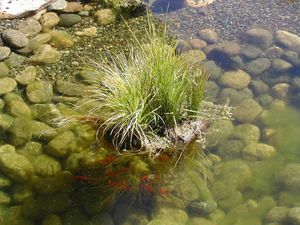Carex nebrascensis
Nebraska Sedge
Click here for print friendly version.
Nebraska Sedge is found in wet meadows and disturbed riparian areas. It is adapted to alkaline soils. This species has long rhizomes and forms small and occasionally large clumps with the previous year's leaves remaining at the base of the plant. This species flowers from May to July and its fruits have a small beak at the tip and are brown to almost black. Nebraska Sedge has triangular stems and is a bluish green color that often has a white tinge. Nebraska Sedge is naturally found in the American West and was introduced to St. Louis County.
Additional Information:
|
Height |
Spread |
|
Bloom/Seasonal Color |
USDA Hardiness Zone 4-6
Home Owner Growing and Maintenance Tips:
|
Good Companions
Sweet Flag
(Acorus calamus),
Marsh Milkweed
(Asclepias incarnata),
Palm Sedge
(Carex muskingumensis),
Crowfoot Fox Sedge
(Carex crus-corvi),
Frank's Sedge
(Carex frankii),
Gray's Sedge
(Carex grayi),
Buttonbush
(Cephalanthus occidentalis),
Monkey Flower
(Mimulus ringens),
Cardinal Flower
(Lobelia cardinalis),
Copper Iris
(Iris fulva)
|
Characteristics & Attributes
Hydrologic Designation
|
Root |
Season of Interest
|
||||||
Soil Moisture
|
Special Uses
|
Sun Exposure
|
||||||
USFS MO Ecological Map |
Wildlife Benefit
|

